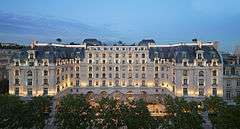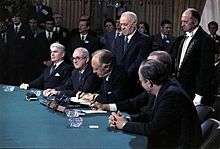The Peninsula Paris
| The Peninsula Paris | |
|---|---|
 The Peninsula Paris | |
| General information | |
| Location | Paris, France |
| Address | 19 Avenue Kléber |
| Opening | 1908, 2014 |
| Owner | Katara Hospitality, Hong Kong and Shanghai Hotels |
| Management | The Peninsula Hotels |
| Design and construction | |
| Architect | Armand Sibien (1908), Richard Martinet (2014) |
| Developer | Leonard Tauber |
| Other information | |
| Number of rooms | 200 |
| Number of suites | 34 |
| Website | |
| paris.peninsula.com | |
The Peninsula Paris is a historic luxury hotel, formerly known as the Hotel Majestic, located on Avenue Kléber in the 16th arrondissement of Paris, France. It opened in 1908 and was converted to government offices in 1936. The hotel served as a field hospital for wounded officers during World War I , staffed largely by British aristocrats. During World War II it served as the headquarters of the German military high command in France during the Nazi occupation of Paris. The hotel played a pivotal role in the deportation of Parisian Jews and the 1944 assassination attempt on Hitler. The building reopened as The Peninsula Paris in August 2014 following a complicated and costly restoration.
History
Early History of the site
Avenue Kléber, part of Baron Haussmann's rebuilding plan for Paris, was originally known as avenue du Roi de Rome in tribute to Napoleon I’s son. In 1864, a rich Russian nobleman named Alexandr Basilewski constructed a palace at 19 avenue du Roi de Rome, designed by architect Clément Parent.[1] Basilewski sold the palace in 1868 to Queen Isabella II of Spain, who established the palace as her home in exile during the First Spanish Republic. She continued to live there for the next 36 years and the palace was known as the Palais de Castille. After the queen’s death, the property was acquired by hotel magnate Leonard Tauber after a bidding war that involved the United States government and the King of Belgium.[1]
The Hotel Majestic
Tauber constructed the luxurious Hotel Majestic on the site, retaining Queen Isabella's bathroom accoutrements, including her marble bath, in the Presidential suite.[1][2] Designed by Armand Sibien,[3] construction began in 1906 and the hotel opened in December 1908.[4] The hotel was purchased by Henry Devenish Harben for use as a military hospital at the outbreak of World War I in 1914,[5] and served in this capacity for five months. It was damaged during its hospital service, and was not renovated and reopened until 1916. In 1922 it was the site of a famous dinner hosted by Violet and Sydney Schiff and attended by Marcel Proust, Igor Stravinsky and Pablo Picasso. The "dinner party of the century": was immortalised in Richard Davenport-Hines's book, "Proust at the Majestic: The Last Days of the Author Whose Book Changed Paris". The 1st unofficial Chess Olympiad was held at the hotel in 1924. George Gershwin wrote An American in Paris while staying at the hotel in 1928.[4]
World War II
The hotel was purchased by the French government in 1936 to serve as offices for the Ministry of Defence.[3] It served as the headquarters of the German military high command in France (Militärbefehlshaber Frankreich)[6] from October 1940 to July 1944 during the occupation of Paris in World War II.[3] During the Nazi Occupation of Paris, staff army officials at The Majestic fought fierce battles with the Gestapo and the SS over policy, especially with regard to the deportation of Jews to concentration camps, reprisals against French partisans and protection of works of Art in French museums. The Majestic became known as a centre of opposition to certain aspects of Adolf Hitler's policies, especially when Carl-Heinrich von Stülpnagel took charge of administering the Militärbefehlshaber Frankreich.[7]
On May 22, 1942 after the Wannsee conference an exclusive presentation was made to the higher echelons of the German army at the Hotel Majestic by Reinhard Heydrich, one of the main architects of the Holocaust. He spoke of experiments[8] for the killing of Jews using a specially prepared truck whose exhaust fumes would kill the deportees. In this context the word “gassing” was first used outside of Hitler's inner circle in relation to the extermination of the Jewish population of Paris.[7] On this occasion, Heydrich introduced Carl Oberg, the new police and SS officer for Paris, who had been issued with the authority to order deportations of Jews without reference to the military commander of the French authorities. Militärbefehlshaber Frankreich staff at The Majestic were soon processing hundreds of deportation orders against the Jewish population of Paris. Joseph Goebbels established his Paris propaganda headquarters at the Majestic around the same time and the building's staff assumed control of the notorious Camp Royallieu at Compiègne, know to the Germans as Frontstalag 122, which served as a feeder station for the extermination camps at Auschwitz, Ravensbrück, Buchenwald and Dachau.[9]
Stülpnagel opposed the policy and decided to act against Hitler. With other members of the officer class working out of The Majestic and billeted in The Raphael next door, Stülpnagel began to plan Hitler's assassination from his office on The Majestic's second floor. On 20 July 1944, Stülpnagel's co-conspirator Claus von Stauffenberg made his assassination attempt on Hitler at the Wolfsschanze in East Prussia. For his part, Stülpnagel put his part of the plot into operation from The Majestic, ordering Hans Otfried von Linstow to round up all SS and Gestapo officers in Paris and imprison them. These events were witnessed by Walter Bargatzky, a high ranking German officer who wrote "Hotel Majestic: Ein Deutscher im besetzten Frankreich" and was a supporter of the plot to kill Hitler. After the plot failed, Bargatzky left his office at The Majestic and returned to room 409 in The Raphael to await his arrest. It never came and like other fringe members of the plot, Bargatzky was allowed to serve out the war at The Majestic.
The final battle for The Majestic took place on 25 August in the afternoon as Jaques Massu and Colonel Paul de Langlande of the 2nd Armored Division (France) moved their troops from the Champs-Élysées to the heavily fortified and barricaded Avenue Kleber.[10] One of Massu's officers worked his way around the rear of The Majestic on Rue la Perouse, which was protected by a blockhouse that could only be subdued by a bazooka, but the Germans inside the hotel said they would be willing to surrender to regular soldiers, rather than men of the Resistance. A German spokesman was brought to Massu under a white flag and with Langland'e approval, Massu went to The Majestic accompanied by Senior Sergeant Dannic. As they approached Dannic was shot dead by a sniper firing from the hotel's rooftop. Despite this, Massu continued up the hotel's steps and entered The Majestic's lobby to find fifty German officers and 300 other ranks. The Germans surrendered to Massu without further resistance, using a bilingual bell-boy from the hotel as their interpreter.[10]
Government offices
In the post war-era The Majestic served as the first headquarters of UNESCO,[11] from September 16, 1946[3] until 1958, when it was converted into a conference center for the French Ministry of Foreign Affairs,[12] known as the International Conference Center. The Organisation for Economic Co-operation and Development was founded at the hotel in 1960[13] and it was the location for the signing of the Paris Peace Accords on January 27, 1973[14] that ended American involvement in the Vietnam War.[4] Later, on October 23, 1991, the 1991 Paris Peace Accords, which ended the Cambodian-Vietnamese War and Khmer Rouge civil war, were also signed there.[15]
The Peninsula Paris
In July 2016 The Peninsula Paris received the Palace distinction bestowed by the French agency ATOUT France, entering the closed corcle of Parisian Palaces. The French government sold the building in 2008 as part of a cost-cutting measure to the Qatari Diar firm for $460 Million. It reopened on August 1, 2014,[16] following extensive rebuilding by Vinci Construction[17] costing EUR338 million,[18] as The Peninsula Paris, the famous hotel chain's first property in Europe, in a joint venture with Katara Hospitality. The Hongkong and Shanghai Hotels, Limited, parent company of Peninsula Hotels, owns a 20% interest in the property.[19] The architectural designs were by Richard Martinet of Affine architecture & interior design, while the interiors were by Henry Leung of Hong Kong-based Chhada Siembieda & Associates Ltd.[20] The hotel offers 200 luxury rooms, including 34 suites. Five of the suites have private rooftop gardens with a panoramic view of the most emblematic monuments in Paris.
Restaurants and Bars
- Le Lobby: Open for breakfast through to post-dinner drinks and late-night suppers, it’s also home to the Peninsula Afternoon Tea.
- LiLi: With a theme inspired by both Chinese and French opera, Lili restaurant takes Cantonese cuisine in Paris.
- L'Oiseau blanc:Six floors further up, the restaurant and terrace bar, l’Oiseau Blanc, spreads its wings over the rooftops of Paris and over some of her most iconic monuments.The restaurant’s French aviation theme pays homage to the biplane, l’Oiseau Blanc, one of the first aeroplanes to attempt the Atlantic crossing.
- Le Lounge Kléber: Cigar and drinks
- La Terrasse Kléber: Serves international dishes, drinks and snacks throughout the day.
- Le Bar Kléber: Cocktails, fine wines, Champagnes, spirits and international whiskies.
21 avenue Kléber
The Second Empire building was acquired in 2013 by The Peninsula Hotels and located next to Peninsula Paris.[21] Built in 1900, the building is a commercial building along the historic Avenue Kléber.
Gallery
- The Peninsula Paris
 The Peninsula Paris, front entrance, October 2014
The Peninsula Paris, front entrance, October 2014- German officers captured by Free French troops are lodged in the Hôtel Majestic
 Plaque commemorating Raymond Bonenfant, who was killed at 17 rue Galilée in the battle for the nearby Hotel Majestic
Plaque commemorating Raymond Bonenfant, who was killed at 17 rue Galilée in the battle for the nearby Hotel Majestic Signing the Paris Peace Accords, 1973
Signing the Paris Peace Accords, 1973.jpg) Construction at The Peninsula Paris, June 2012
Construction at The Peninsula Paris, June 2012
References
- 1 2 3 The Making of the Peninsula Paris by Daniel Jeffreys at www.thepeninsula-paris.com
- ↑ "Tauber". heritageechecsfra.free.fr. Retrieved 2014-04-24.
- 1 2 3 4 "PSS / Hôtel Le Peninsula Paris (Paris, France)". pss-archi.eu. Retrieved 2014-04-24.
- 1 2 3 "The Peninsula Paris". paris.peninsula.com. Retrieved 2014-04-24.
- ↑ Elizabeth Crawford, The Women's Suffrage Movement: A Reference Guide 1866-1928, pp.269-271
- ↑ Samuel Rousselier, sml-studio : conception interactive et développement. Benjamin Brard : conception graphique. "Histoire@Politique : comptes-rendus : Gaël Eismann, Hôtel Majestic. Ordre et sécurité en France occupée (1940-1944),". histoire-politique.fr. Retrieved 2014-04-24.
- 1 2 Walter Bargatzky, Hotel Majestic: Ein Deutscher im besetzten Frankreich
- ↑ Arrivée du Général des SS Heydrich par Les Actualités Mondiales at Ina.fr
- ↑ Charles Glass, Americans in Paris: Life and Death Under Nazi Occupation
- 1 2 Free France's Lion: The Life of Philippe Leclerc, de Gaulle's Greatest General by William Mortimer Moore
- ↑ "Paris Headquarters | United Nations Educational, Scientific and Cultural Organization". unesco.org. Retrieved 2014-04-24.
- ↑ "Hotel Preview: The Peninsula Paris to Debut Aug. 1 | TravelPulse". travelpulse.com. Retrieved 2014-04-24.
- ↑ "A majestic start: How the OECD was won - OECD Observer". oecdobserver.org. Retrieved 2014-04-24.
- ↑ "Vietnam Accord is Reached; Cease-Fire Begins Saturday; P.O.W.'s to be Free in 60 Days". nytimes.com. Retrieved 2014-04-24.
- ↑ Cambodia's Curse. Retrieved 2015-01-02.
- ↑ "The Peninsula Paris opens". Telegraph.co.uk. Retrieved 2015-01-02.
- ↑ "Les archives des dossiers du mois". vinci-construction.fr. Retrieved 2014-04-24.
- ↑ "The Peninsula Paris | The Hongkong and Shanghai Hotels, Limited". hshgroup.com. Retrieved 2014-04-24.
- ↑ http://www.hshgroup.com/en/Property-Management-Portfolio/The-Peninsula-Hotels.aspx
- ↑ "The Peninsula Paris Makes a Spectacular Entrance". luxurytravelmagazine.com. Retrieved 2014-04-24.
- ↑ http://www.hshgroup.com/en/Property-Management-Portfolio/Commercial-Residential-Properties-Management/21-avenue-Kleber.aspx
External links
| Wikimedia Commons has media related to The Peninsula Paris. |
Coordinates: 48°52′16″N 2°17′36″E / 48.8710°N 2.2933°E